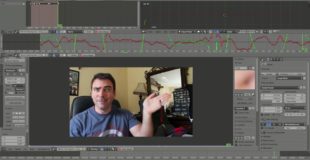https://i.ytimg.com/vi/c0WhYNfZ1KI/hqdefault.jpg
Example video for tracking:
Webpage – http://filmsbykris.com
Support – https://www.patreon.com/metalx1000
Donate – https://www.paypal.com/cgi-bin/webscr?cmd=_s-xclick&hosted_button_id=J9FK6WWVRQMG6
Other Channel – https://www.youtube.com/channel/UCFsvtR4aNPwefLjR1a9Hgvg
This video was sponsored by:
Karl Arvid
Steven C. Morreale
For help: http://filmsbykris.com/irc
FaceBook: https://www.facebook.com/pages/Films-By-Kris/225113590836253
source

15 responses to “Motion Tracking with Blender 3D”
best 16 minutes tutorial, explained well, better that 40 mins vid i watched, please upload the camera tracking
You might be getting aborted tracks because you are not properly setting your track search area. You set the smaller pattern area that the software uses to match each subject position, but the search area restricts how far a subject can move before the tracker can no longer find a match to the track pattern. Your hand is moving pretty far between frames, and may be exceeding the extent of the search area. You need to turn on visibility of the search box in the parameters.
Technically, this example should be tracked in 3d, but if you confine your movement to a small area in the plane parallel to the camera view plane, you can fake 2d motion in 3d. Another reason the object slides against your hand is that you are not rendering the object with motion blur. Your hand is heavily blurred so it tends to distort or stretch in relation to the non-blurred object. Tracking motion-blurred subjects can be tricky because you need to determine a consistent point to track on the blur – either the leading edge, center, or trailing edge of the blur. Failing to observe this will result in an object that slides around during fast motion even if it is rendered with motion-blur.
I worked extensively in 3d effects tracking, and this became a problem because the matchmakers were tracking with one part of the blur, such as center-blur, and the renderers were setting their camera shutter to something else – such as leading edge. Then they would complain that the match move did not track properly when it was composited. It can create a lot of hair-pulling and arguments over who is screwing up.
There are a lot of minute, nit-picky technical details to motion tracking that can cause these sorts of problems if each detail is not properly observed.
Hey Kris, great tutorial. I have a question. I was trying to use this technique to track facial deformation. The steps I went through is add a set of markers on my face, then tracked those. Then I hit the "Link Empty to Track". That creates the empties in the 3D view and they follow my facial deformation. Each empty has a follow track constraint, following the specific track. But now I want to take the transformation and convert them into an f-curve. Under the constraint for the track I press "Constraint to F-curve" but that doesn't do anything. No keyframes are created. I'm using Blender 2.79. Do you have any ideas why that would be happening. Thanks in advance.
how did u make the image in compositing smaller ??
most of the tracking vids for blender I've seen where for Blender 2.6 🙁 any chance in which, I've noticed that a lot of things are different from recent versions. Any chance you can do a camera tracking vid? especially now that we're so close to Blender 2.79?
how do I motion track a png image of my choice?
Dude, I was about to drop my big project idea, until I saw your tutorial! Watched two great motion tracking lessons, but I was still missing something, and your video brought that final piece of a puzzle to understand the process. Thanks!
Excellent as always Kris!!
Do you also accept request to make an 1 minute video for me 🙂 ?
Thanks – Seems a great method. I would like to try is to use a movie of animal motion to help get animation onto the limbs & body of an animal model…Hope it will work!
Oops looks like your video capture didn't show us the systems menu around 2:40 etc.
4:40
One thing to note here is that changing the tracking settings on the left panel will only effect newly placed tracking markers. To change the settings for the currently selected marker you want to go to the "tracking settings" dropdown on the right panel. (the panel revealed by pressing 'n')
This can be a bit of a hair puller if you don't know that blender works in this way because at first it appears like blender is sometimes ignoring your settings. But it all makes sense because there are times when different markers will require different tracking settings in order to get a good track on a point, and global settings for all tracking markers would make that impossible to pull off. A part of me thinks they should rename the left panel to something like "New Marker Settings" or something to make this a little more clear from the get go.
Cool! Will you do a pitch, roll and yaw to show an xyz example? Like say, if you held a wii remote in your hand and replaced it with a 3D object? Actually I just thought of something. One could replace the real wii remote with a 3D model of an identical wii remote… just for lols.
its nice
Good video thanks!